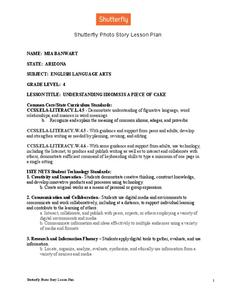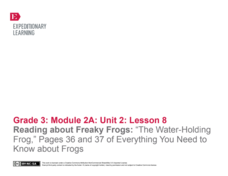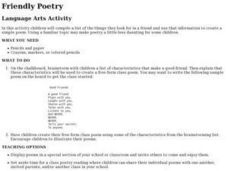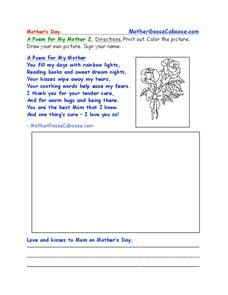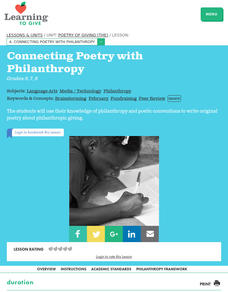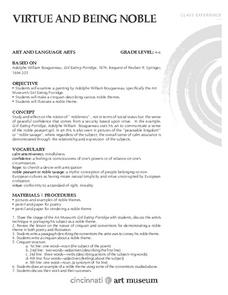Curated OER
Coin Poems
Students recite a poem that aids in coin recognition. They memorize a poem that helps them identify the shape and worth of a penny, nickel, dime and quarter.
Curated OER
Beowulf: Lesson Plan and Supplementary Materials
A reading of Beowulf: Dragon Slayer, Rosemary Sutcliff's retelling of the classic epic poem, launches an exploration of what it means to be a hero, a noble leader, and a great warrior. A great way to introduce middle schoolers to...
Curated OER
Number The Stars Diamante Poem
In this language arts worksheet, students read the rules and format for a diamante poem. They fill in the lines on page 2 while following the guidelines.
Roald Dahl
The Twits - Mrs Twit
"A person who has good thoughts cannot ever be ugly." The second lesson plan in an 11-part unit that accompanies The Twits by Roald Dahl uses poetry to encourage positive character traits. Mrs. Twit has ugly thoughts, but those...
Shutterfly
Photo Story Lesson Plan
After reading Loree Leedy's There's a Frog in My Throat: 440 Animal Sayings a Little Bird Told Me, kids create and illustrate their own poems that convey the meaning of an idiom. The poems are then transferred into Shutterfly's Photo...
Curated OER
The Tiger!
William Blake's immortal poem "The Tiger!" launches a study of these magnificent creatures. After a close reading of the poem, class members compare his poem to Blake's artwork. Individuals then choose a favorite tiger species to...
K12 Reader
Figurative Language: Edgar Allan Poe’s “The Bells”
Bells, bells, bells abound in a worksheet designed for Edgar Allan Poe's famous poem "The Bells." Middle schoolers are asked to identify the various poetic devices Poe employs.
EngageNY
Reading about Freaky Frogs: “The Water-Holding Frog"
Boost reading comprehension skills with a lesson all about freaky frogs. A poem hooks scholars and takes them into a reading of an informational text followed by peer discussions. A three-page worksheet focuses on text features and...
Alabama Learning Exchange
Edgar Allan Poe's Journey Through Life and Literature
How was Edgar Allan Poe able to create "intriguing, memorable, and lasting literature"? To answer this question, learners analyze the syntax, diction, and characterizations in Poe's poems and short stories and compare the impact of these...
Curated OER
Archetypal Images and Polarities
Here is a rather esoteric resource that presents the archetypes found in “The Epic of Gilgamesh,” and would be appropriate for a college-level psychology or literature class, or as a teacher resource. Considered the “world’s oldest...
Curated OER
Haiku
In this poetry worksheet, students read about how to write a haiku poem. Then, students write a their own haiku and a reflection about their poem.
Freeology
Bio Poem Template
A template for the bio poem, a popular form poem, will come in handy at the beginning of the school year. Ask pairs to craft a bio poem for a partner, illustrate the poem, use the graphic to introduce his partner to the class, and then...
Curated OER
Sun and Moon Poetry Baskets
Pupils write Sun and Moon poetry. For this poetry lesson, students research the sun and the moon. They write poetry and create two class baskets for descriptive words about each.
Curated OER
Friendly Poetry
In this activity, students will compile a list of the things they look for in a friend and use that information to create a simple poem. Using a familiar topic may make poetry a little less daunting for some children.
Curated OER
Mother's Day
In this holiday activity, students color in a bouquet of flowers and illustrate a poem about Mother's Day. The poem begins with, "You fill my days with rainbow lights..."
Curated OER
Connecting Poetry with Philanthropy
Young scholars examine the different types of poetic conventions. They write a poem about philanthropy using these conventions. They illustrate their poem with artwork of their choice.
Curated OER
Munsch mania
Third graders choose a Robert Munsch poem to interpret. In this language arts lesson, 3rd graders interpret their chosen poem by either acting it out or through illustrations. Once the interpretations are complete, students send their...
Curated OER
Adventures in Alice
Students create a haiku and illustrate it on the computer. In this haiku lesson plan, students review the history of the haiku while they are outside and then write their own. Students then use a computer program to illustrate their poem.
Curated OER
Virtue And Being Noble
Students write and illustrate original cinquains based upon the ideas of nobility and virtue. The lesson includes a vocabulary list of key terms and rubric for student reflection and assessment. This is intended for a 4th through 6th...
Curated OER
Figurative Language Project
Want a handy way to remember the difference between metaphors and similes, or allusions and alliteration? Individuals craft their own figurative language booklet, complete with definitions, examples, and illustrations, following...
Reed Novel Studies
Rules: Novel Study
Have you ever been so focused on others, that a look in the mirror surprises you? It seems that Catherine, a character in Rules, does just that when she focuses so much on her autistic brother's behaviors that she is surprised by her own...
Curated OER
Native American Poetry
Fourth graders locate the poetry section of the LMC. They produce a hand written transparency based on the poem Hiawatha by Henry Wadsworth Longfellow. Students illustrate a poem from their poetry section. It is a mystery to them what...
Curated OER
Friendly Poetry
Students brainstorm qualities that they look for in a good friend. They use those qualities to write a class poem. They are to illustrate their poems with crayons or markers.
Curated OER
WHAT DO BEARS EAT AND HOW DO THEY WALK?
Students listen to the poem "Five Bears" read aloud several times, and study what bears eat by naming the foods (mentioned in the poem) out loud. They draw a picture to illustrate one line of the poem and practice choral reading.






